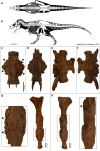A comprehensive diagnostic approach combining phylogenetic disease bracketing and CT imaging reveals osteomyelitis in a Tyrannosaurus rex
- PMID: 33144637
- PMCID: PMC7642268
- DOI: 10.1038/s41598-020-75731-0
A comprehensive diagnostic approach combining phylogenetic disease bracketing and CT imaging reveals osteomyelitis in a Tyrannosaurus rex
Abstract
Traditional palaeontological techniques of disease characterisation are limited to the analysis of osseous fossils, requiring several lines of evidence to support diagnoses. This study presents a novel stepwise concept for comprehensive diagnosis of pathologies in fossils by computed tomography imaging for morphological assessment combined with likelihood estimation based on systematic phylogenetic disease bracketing. This approach was applied to characterise pathologies of the left fibula and fused caudal vertebrae of the non-avian dinosaur Tyrannosaurus rex. Initial morphological assessment narrowed the differential diagnosis to neoplasia or infection. Subsequent data review from phylogenetically closely related species at the clade level revealed neoplasia rates as low as 3.1% and 1.8%, while infectious-disease rates were 32.0% and 53.9% in extant dinosaurs (birds) and non-avian reptiles, respectively. Furthermore, the survey of literature revealed that within the phylogenetic disease bracket the oldest case of bone infection (osteomyelitis) was identified in the mandible of a 275-million-year-old captorhinid eureptile Labidosaurus. These findings demonstrate low probability of a neoplastic aetiology of the examined pathologies in the Tyrannosaurus rex and in turn, suggest that they correspond to multiple foci of osteomyelitis.
Conflict of interest statement
The authors declare no competing interests.
Figures






Similar articles
-
Molecular phylogenetics of mastodon and Tyrannosaurus rex.Science. 2008 Apr 25;320(5875):499. doi: 10.1126/science.1154284. Science. 2008. PMID: 18436782
-
Palatal Biomechanics and Its Significance for Cranial Kinesis in Tyrannosaurus rex.Anat Rec (Hoboken). 2020 Apr;303(4):999-1017. doi: 10.1002/ar.24219. Epub 2019 Jul 18. Anat Rec (Hoboken). 2020. PMID: 31260190
-
Common avian infection plagued the tyrant dinosaurs.PLoS One. 2009 Sep 30;4(9):e7288. doi: 10.1371/journal.pone.0007288. PLoS One. 2009. PMID: 19789646 Free PMC article.
-
Morphology and distribution of scales, dermal ossifications, and other non-feather integumentary structures in non-avialan theropod dinosaurs.Biol Rev Camb Philos Soc. 2022 Jun;97(3):960-1004. doi: 10.1111/brv.12829. Epub 2022 Jan 6. Biol Rev Camb Philos Soc. 2022. PMID: 34991180 Review.
-
Orthopedic Diagnostic Imaging in Exotic Pets.Vet Clin North Am Exot Anim Pract. 2019 May;22(2):149-173. doi: 10.1016/j.cvex.2019.01.003. Vet Clin North Am Exot Anim Pract. 2019. PMID: 30961896 Review.
Cited by
-
Quantitative dual-energy CT as a nondestructive tool to identify indicators for fossilized bone in vertebrate paleontology.Sci Rep. 2022 Sep 30;12(1):16407. doi: 10.1038/s41598-022-20707-5. Sci Rep. 2022. PMID: 36180510 Free PMC article.
-
Novel report of an osteogenic tumor in a late Jurassic Mamenchisaurid from Thailand.J Anat. 2025 Sep-Oct;247(3-4):699-711. doi: 10.1111/joa.14266. Epub 2025 Apr 24. J Anat. 2025. PMID: 40274378 Free PMC article.
-
New information on paleopathologies in non-avian theropod dinosaurs: a case study on South American abelisaurids.BMC Ecol Evol. 2024 Jan 31;24(1):6. doi: 10.1186/s12862-023-02187-x. BMC Ecol Evol. 2024. PMID: 38291378 Free PMC article.
-
A new styracosternan hadrosauroid (Dinosauria: Ornithischia) from the Early Cretaceous of Portell, Spain.PLoS One. 2021 Jul 7;16(7):e0253599. doi: 10.1371/journal.pone.0253599. eCollection 2021. PLoS One. 2021. PMID: 34232957 Free PMC article.
-
Bony injuries in a Late Triassic forerunner of mammals from Brazil.Naturwissenschaften. 2025 May 6;112(3):36. doi: 10.1007/s00114-025-01984-2. Naturwissenschaften. 2025. PMID: 40327109
References
-
- Tanke, D. H. & Rothschild, B. M. Dinosores: An annotated bibliography of dinosaur paleopathology and related topics—1838–2001: Bulletin 20. Vol. 20 1–97 (New Mexico Museum of Natural History and Science, 2002).
-
- Rothschild B. Scientifically rigorous reptile and amphibian osseous pathology: Lessons for forensic herpetology from comparative and paleo-pathology. Appl. Herpetol. 2009;6:47–79. doi: 10.1163/157075409x413842. - DOI
-
- Rothschild BM, Tanke D. Paleopathology of vertebrates: Insights to lifestyle and health in the geological record. Geosci. Can. 1992;19:73–82.
Publication types
MeSH terms
LinkOut - more resources
Full Text Sources
Medical

